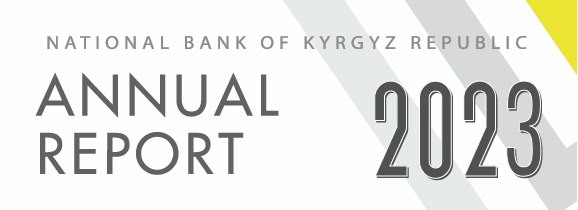Monetary Policy Report for January to September 2009
Approved
Resolution of the Board of the NBKR
No 46/3 of November 18, 2009
1.1. Basic Monetary Policy Trends
The Statement “Monetary Policy for 2009” specified that the basic objective of monetary policy implementation is to restrain inflation and maintain stability of a general price level, as one of the basic conditions of sustainable economic growth in the long run. A quantitative monetary policy criterion for 2009 was set at a level below 15 percent. In August, the Board of the NBKR took a decision to revise the quantitative monetary policy criterion downward to the level of no more than 7.5 percent. Such a decision was conditioned by a reduction of an inflationary pressure and was directed to instill adequate expectations in business communities and the population that would help to vitalize economic activities, alongside with anti-crisis measures of the Government and the National Bank.
According to data of the National Statistics Committee for January to September 2009, the general price level in the republic was observed to decrease by 1.7 percent, and an annual rate of inflation (September 2009 against September 2008) was 2.1 percent.
The current year reduction of the inflationary pressure created favorable conditions for easing the monetary policy, with its implementation being nevertheless complicated on impact of the world financial crisis and expenditures of the Government, which caused an economic recession, the reduction of an inflow of foreign exchange in the republic, and a weakening of the national currency.
Due to growth of budget expenditures observed in the 2nd quarter and at the beginning of the 3rd quarter, the National Bank increased an offer of NBKR Notes, whose outstanding volume totaled Som 1.4 billion in July (Som 0.9 billion - at the end of March). Subsequently, as activity in conducting budgetary operations slackened, the National Bank reduced the offer of NBKR Notes in the 3rd quarter of 2009, having brought their outstanding volume at the end of September to the level of about Som 1.0 billion. For January to September 2009 as a whole, growth of a monetary base was 3.9 percent (with 10.7 percent for the similar period of 2008), and from the beginning of the 4th quarter of the current year (as of October 29, 2009) the monetary base increased by 2.9 percent.
Since early-year, the discount rate of the NBKR had been consistently decreasing and reached the level of 3.3 percent by the end of the accounting period and it is by 11.9 percentage points lower than the level observed at the beginning of the year. The decrease in the discount rate corresponds to a tendency of easing the inflationary pressure.
Altogether for a period of January to September 2009, the discount nominal dollar exchange rate vis-а-vis the Som grew by 10.7 percent, being Som 43.63 for 1 US dollar at the end of September.
The volume of net January-September 2009 sales by the NBKR of US dollars at interbank foreign exchange sales totaled US$ 144.1 million (in the similar period of 2008, these were net purchases that totaled US$ 84.4 million).
Generally, for 9 months of 2009, the volume of required reserves increased by 47.6 percent, to Som 3.8 billion, owing to, mainly, the inflow of deposits. Growth of required reserves was also affected by an increase since June 1 in the dollar exchange rate (from Som 36 for 1 US dollar to Som 43 for 1 US dollar), applied to recalculate the volume of foreign exchange deposits when calculating reserve requirements.
In the 3rd quarter of 2009, operations of a Specialized Bank Refinancing Fund (SBRF) became more active. In July and September amendments were introduced into the SBRF’s Charter and the Bank Refinancing Policy, according to which the SBRF can finance not only a banking sector, but the microfinance sector as well. A procedure of defining a value of SBRF credit resources was also changed. According to this procedure, not the NBKR discount rate is taken as a basis, but the base rate, which is defined and established by the NBKR’s Monetary Regulation Committee on the monthly basis. In September, the base rate for lending by the SBRF was established at the rate of 8.0 percent.
In January to September 2009 generally, there was a twofold slowdown of rates of real economic growth in the economy in comparison with the similar period of 2008, to 2.9 percent, as a result of, mainly, an effect of the world financial and economic crisis and a recession in the regional trading partner countries.
According to the preliminary data, the balance of payments developed in January to September 2009 as positive - at the rate of US$ 201.7 million (in January to September 2008 a surplus was US$ 103.8 million). The current account developed positive and equal to US$ 51.0 million due to the reduction of a trade gap resulting from the larger reduction of import compared to export, as well as from a receipt of the Russian grant. The current account deficit was noted to be US$ 444.5 million in the similar period of 2008. The positive balance of current transfers decreased in the accounting period by 15.9 percent and developed at the rate of US$ 924.0 million. In this regard, excluding the Russian grant, the decrease in the current transfers was equal to 29.6 percent.
Based on the outcome of the period of January to September 2009, assets of commercial banks increased by 26.2 percent, while capital - by 10.2 percent. As of end-September 2009, the deposit base of operating commercial banks increased by 20.7 percent and totaled Som 35.7 billion. At the same time, a loan portfolio of operating commercial banks contracted by 1.6 percent for the accounting period, having amounted to Som 25.2 billion. Reportedly, a factor of safety of domestic commercial banks is sufficient to stand the long crisis of the world financial and economic system and a probability of this crisis to result in the systemic banking crisis is low (liquidity of the banking system is more than 80 percent, with the normative value of this factor being 30 percent).
1.2. Inflation: Outcomes and Trends
The third quarter of 2009 would be still described by the tendency of the slowdown of growth of the general price level in the republic, which was characteristic of also the first two quarters of the year. According to the data of the National Statistics Committee, the 12 month value of inflation (September 2009 against September 2008) was 2.1 percent, whereas for the similar period of the last year it was 25.9 percent. Since early-2009, the general price level was observed to have decreased by 1.7 percent in the republic (against December 2008), whereas for the corresponding period of 2008 it was noted to grow by 15.6 percent.
The factors of the current price behavior were those of stabilization in the world markets of food products and energy resources with their subsequent downward adjustment, and the resultant reduction of import prices, the weakening of domestic and external demand, as well as the anti-inflationary measures undertaken by the National Bank and the Government
Table 1. Consumer Price Index in the Kyrgyz Republic
|
|
September 2009 against |
January-September 2009 against |
||
|
September 2008 |
December 2008 |
August 2009 |
January- September 2008 |
|
|
Total goods and services of which |
102.1 |
98.3 |
100.2 |
109.1 |
|
Foodstuffs and soft drinks |
94.6 |
90.9 |
99.5 |
104.0 |
|
Alcoholic and tobacco products |
106.8 |
104.4 |
100.5 |
108.1 |
|
Nonfoods |
111.7 |
108.0 |
101.1 |
114.0 |
|
Services |
109.5 |
104.2 |
100.2 |
123.1 |
The decrease in the general level of consumer prices was essentially influenced by the food price behavior. For instance, an annualization of prices shows that there was an abatement of prices of foodstuffs and soft drinks (-5.4 percent), including those of bakery products and groats - by 16.1 percent, oils and fats - by 18.9 percent, and those of fruit and vegetables - by 5.7 percent.
The annualization of prices of alcoholic and tobacco products indicates the increase by 8.9 percent and 2.4 percent, accordingly.
Though slightly slowed down, growth of the nonfood price index remained still high and was 11.7 percent in September 2009 as against the prices of September 2008 (17.5 percent for the similar period of 2008).
The annualization of the price index of marketed services displayed growth by 9.5 percent (in the similar period of 2008 - by 33.5 percent).
1.3. Dynamics of Monetary Indicators
The monetary base was Som 36 510.6 million at the end of September 2009, having increased by 3.9 percent from the beginning of the year (in the similar period of 2008 the increase was 10.7 percent).
Money outside banks M0 totaled Som 29 448.8 million at the end of September 2009, having increased by 0.2 percent from the beginning of the year, in the similar period of 2008 the increase was 9.7 percent.
Money supply М2 was Som 38 004.8 million at the end of September 2009 and contracted in comparison with the beginning of 2009 by 0.5 percent as a result of the decrease in the deposits in national currency by 3.0 percent, with money outside banks having grown by 0.2 percent.
Broad money М2Х, including the deposits in foreign currency, was Som 49 543.9 million at the end of the accounting period, having thus increased by 2.3 percent as against an early year parameter.
Broad money М2Х in the accounting period grew on impact of the increase in money outside banks by 0.2 percent and the increase in total deposits, which are part of broad money, by 5.4 percent, including the deposits in foreign currency by 12.6 percent, with the deposits in national currency having decreased by 3.0 percent.
A velocity of broad money М2Х, including the deposits in foreign currency, was 4.4 at the end of the accounting period.
1.4. Real Sector
Based on the outcome of January to September 2009, the volume of GDP was Som 137 223.6 million, having increased by 2.9 percent in real terms in comparison with the similar period of 2008 (in January to September 2008, real growth was 5.9 percent). Excluding enterprises developing a gold mine deposit “Kumtor”, real growth of GDP was 3.6 percent as against 4.9 percent in January to September 2008.
As a whole, essential growth retardation has been observed in the economy since the beginning of the current year.
Table 2. Contribution of Specific Activities to Growth/Reduction of GDP in January to September
(percent)
|
|
Share in Jan-Sep 2008 |
Share |
Share in Jan-Sep 2009 |
Growth rate in Jan-Sep 2008 |
Growth rate in Jan-Sep 2009 |
Contribution of growth |
Deflator |
|
Agriculture & forestry |
28.7 |
29.3 |
25.8 |
1.5 |
5.0 |
1.4 |
-9.3 |
|
Mining |
0.4 |
0.4 |
0.5 |
-3.1 |
3.2 |
0.0 |
21.7 |
|
Manufacturing |
10.1 |
8.5 |
9.3 |
13.9 |
-12.7 |
-1.3 |
11.8 |
|
Electricity, gas&water generation&distribution |
2.3 |
2.1 |
2.5 |
-3.0 |
-8.2 |
-0.2 |
25.4 |
|
Construction |
2.6 |
3.3 |
3.5 |
-21.2 |
30.3 |
0.8 |
9.9 |
|
Trade, repairs of vehciles&personal effects |
17.7 |
17.9 |
18.5 |
7.4 |
4.3 |
0.8 |
6.1 |
|
Hotels&restaurants |
1.2 |
1.3 |
1.3 |
9.9 |
5.4 |
0.1 |
8.1 |
|
Transportation&communication |
8.3 |
8.6 |
9.7 |
29.9 |
6.7 |
0.6 |
16.4 |
|
Other |
14.9 |
14.8 |
17.8 |
3.4 |
2.2 |
0.3 |
23.6 |
|
Net taxes on products |
13.7 |
13.7 |
11.1 |
5.9 |
2.9 |
0.4 |
-16.5 |
|
GDP |
100.0 |
100.0 |
100.0 |
5.9 |
2.9 |
2.9 |
3.1 |
Source: NSC data & NBKR adjustments
A high yield in agriculture essentially contributed to the rates of growth of GDP. Approximately half of growth of the total value added in the period under consideration was promoted by agriculture. At the same time, consequences of the world economic crisis had the strong impact on economic growth of Kyrgyzstan. Growth retardation from the beginning of 2009 was conditioned by, mainly, a setback in industrial production. In this regard, the significant decrease in industrial production was observed at the enterprises, which are engaged in extraction of gold. An essential drop in production in the manufacturing industry and in the sector of electricity, gas and water generation and distribution entailed that general business depression.
Essential growth of investment activity is the favorable tendency in the economy. The volume of investments into fixed capital increased in the accounting period by 27.0 percent. One of the principal factors of such growth is that of substantial growth of the volume of investments in energy sector projects, whose share in a composition of total investment into fixed capital is 11.1 percent.
1.5. External Economic Sector
According to preliminary results of January to September 2009, the current account developed positive and equaled to US$ 51.0 million (in view of NBKR adjustments - US$ 251.3 million) whereas in the similar period of 2008 the deficit of US$ 444.5 million was noted in this account.
The balance of trade of the Kyrgyz Republic developed negative at the rate of US$ 861.4 million (in view of NBKR adjustments - US$ 661.1 million). According to the January to September 2009 preliminary data, the balance of services developed positive of US$ 52.0 million as compared to the negative parameter of US$ 116.3 million for the similar period of 2008. In the accounting period, the negative value of the balance of income decreased by 36.6 percent and developed at the rate of US$ 63.5 million and it was caused by the reduction of income of direct foreign investors from investment activity in the Kyrgyz Republic. The positive balance of current transfers decreased in the accounting period by 15.9 percent and developed at the rate of US$ 924.0 million (in this regard, excluding the Russian grant, the decrease in current transfers was 29.6 percent).
The preliminary outcome of the period for January to September 2009 indicates that the capital and financial account developed with the positive balance in the volume of US$ 486.7 million, whereas the corresponding parameter of 2008 was negative of US$ 47.5 million. The balance of the financial account was also in surplus equal to US$ 485.2 million, whereas the corresponding parameter of 2008 was negative of US$ 21.6 million.
In this regard, based on the outcome of the period under consideration, the balance of payments developed positive at the rate of US$ 201.7 million. The volume of total international reserves was US$ 1 496.5 million at the end of the accounting period, thereby covering 4.7 months of import of goods and services.
1.6. Public Finance Sector
According to the Central Treasury of the Ministry of Finance, total state budget revenue and received official transfers in January to August 2009 totaled Som 34 616.4 million or were 30.3 percent of GDP. In this regard, as compared to the corresponding period of the last year, the rates of growth were halved, being 21.2 percent as against 41.3 percent in 2008, being in general lower than the developed mid-annual level of growth.
Maintenance of the budget deficit at the low level was conditioned by receipts of official transfers totaling Som 6 431.6 million from foreign organizations and states that provided for growth of budget revenue by 20.6 percent, while tax and nontax revenue provided for growth of budget revenue by only 0.6 percent (in January to August 2008 – 40.4 percent).
Total state budget expenditure for operational activity in January to August 2009 were Som 29 831.2 million, having increased by 32.5 percent or by Som 7 321.6 million. Growth of budget expenditure was conditioned by, mainly, the 4.5 times increase in expenditures under a category “Other Expenditure” and by 29.1 percent in expenditures classified as “Labor Remuneration”, with each factor having contributed to total growth of budget expenditure by 10.9 percentage points
Besides the increase in operational expenditure, growth was observed in the accounting period in budget allocations for operations on purchases of non-financial assets (including the operations in the following groups: fixed assets, stocks, land and other non-produced assets), which represent capital expenditures of the Government. A net outflow of monetary resources on these operations was Som 5 689.5 million or 5.0 percent to GDP (in January to August 2008 - Som 4 165.3 million or 3.9 percent of GDP).
1.7. Financial Sector
Banking System
As of September 30, 2009, 22 commercial banks operated in the territory of the Kyrgyz Republic.
The banks got a net profit of Som 1 144.3 million for the period of January to September 2009. 22 commercial banks operated in the similar period of 2008 and their profit, based on their performance, was Som 1 316.9 million. For January to September 2009, the assets of commercial banks increased by 26.2 percent, while their capital increased by 10.2 percent.
In January to September 2009, the deposit base of operating commercial banks grew by 20.7 percent, totaling Som 35.7 billion at the end of the period. For instance, for January to September of the current year, the deposits in foreign currency grew by 32.6 percent (growth of deposits in US dollars, whose share in the structure of deposits in foreign currency was 90.6 percent, or 20.4 percent in nominal terms), to Som 22.6 billion, and in national currency - by 4.7 percent, to Som 13.1 billion, at the end of September.
The interest rate of attracted deposits in national currency was 2.6 percent on the average for the period, having thus increased by 0.1 percentage points in comparison with the period of January to September 2008. The average interest rate of newly attracted deposits in foreign currency was 1.6 percent for the period, having risen by 0.9 percentage points
The economic situation in the country in the period of January to September 2009 was characterized by the slowdown of economic activity and increased risks, which created preconditions for the more cautious policy of lending by the banks and resulted in the tightened requirements applied to the credits they extended, as well as in growth of the value of credits. The loan portfolio of operating commercial banks was noted to decrease in the period under review: credit indebtedness of banks decreased by 1.6 percent and was Som 25.2 billion at the end of September.
On the average for the period as a whole, the interest rate of newly extended credits in national currency was 26.8 percent, having risen by 1.0 percentage points in comparison with the period of January to September 2008. The average rate of credits in foreign currency was 21.6 percent, having grown by 1.4 percentage points compared to the similar period of 2008.
Nonbank Finance and Credit Institutions Licensed by NBKR
The system of nonbank finance and credit institutions of the Kyrgyz Republic counted 1 192 nonbank institutions at the end of the accounting period:
· FCSDCU - 1;
· LLC “SFRB” - 1
· Credit unions - 242;
· Microcredit companies - 210;
· Microcredit agencies - 124;
· Microfinance companies - 4;
· Pawnshops - 231;
· Exchange bureaus - 378.
Table 3. Loan Portfolio of Nonbank Finance and Credit Institutions
(in millions of soms).
|
|
12/31/2007 |
09/30/2008 |
12/31/2008 |
09/30/2009 |
|
NFCI Loan portfolio |
4 850.3 |
7 254.3 |
7 384.3 |
8 352.8 |
The data are presented excluding the FCSDCU (because the FCSDCU credits are extended to the credit unions).
Other Financial Institutions
The total volume of tenders on trading platforms of three stock exchanges in January to September 2009 contracted by 41.6 percent, being Som 3 464.7 million in comparison with the corresponding period of 2008. This being the case, the decrease in the volume of tenders was noted with regard to all of the trading platforms. The volume of transactions on the trading platform of the Joint-Stock Company “Kyrgyz Stock Exchange” contracted by 42.6 percent to Som 2 123.1 million, the Joint-Stock Company “Central-Asian Stock Exchange” - by 49.3 percent, to Som 888.3 million, and the volume of foreign exchange sales at the trading platform of the Joint-Stock Company “Stock Exchange of Kyrgyzstan – BTS” contracted by 6.1 percent and was Som 453.3 million. The basic volume of transactions in total tenders fell, as before, with regard to the Joint-Stock Company “KSE” (61.3 percent). In this regard, the basic volume of transactions in January to September 2009 was conducted in the secondary market (56.3 percent) and totaled Som 1951.0 million.
At the end of September 2009, 5 joint-stock investment funds, as well as 2 share investment funds participated in the securities market, with their share in rendering the financial services remaining insignificant: the assets of investment funds remain at the level of 0.02 percent to GDP (based on the outcome of 2008).
19 insurance companies operated in the insurance market of the republic at the end of August 2009, of which there were two re-insurance companies, as well as 7 companies with non-residents as participants. The cumulative assets of insurance organizations were Som 825.3 million for 8 months of 2009, having thus doubled in comparison with the similar parameter of 2008, and their own capital also doubled and totaled Som 724.4 million.
There are currently two non-public pension funds in the Kyrgyz Republic: the NPF “Kyrgyzstan” and the NPF “Zhany Aziya” (which got a license on May 26, 2009, and was not yet engaged in its activity). The size of assets of the NPF “Kyrgyzstan” as of September 1, 2009, was Som 17.0 million, having increased by 13.8 percent for the year as a whole, and the number of its participants, who concluded contracts on voluntary pension insurance, was 2 333 persons (of which 486 persons get pensions), that is by 437 persons, or by 23.0 percent more than as of September 1, 2008.

















